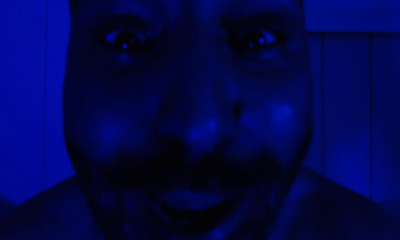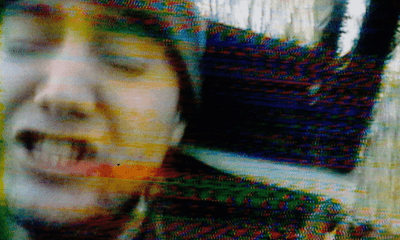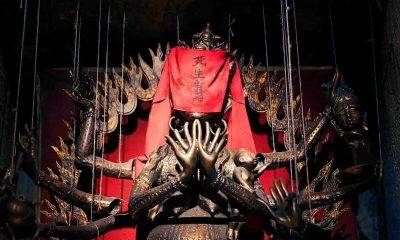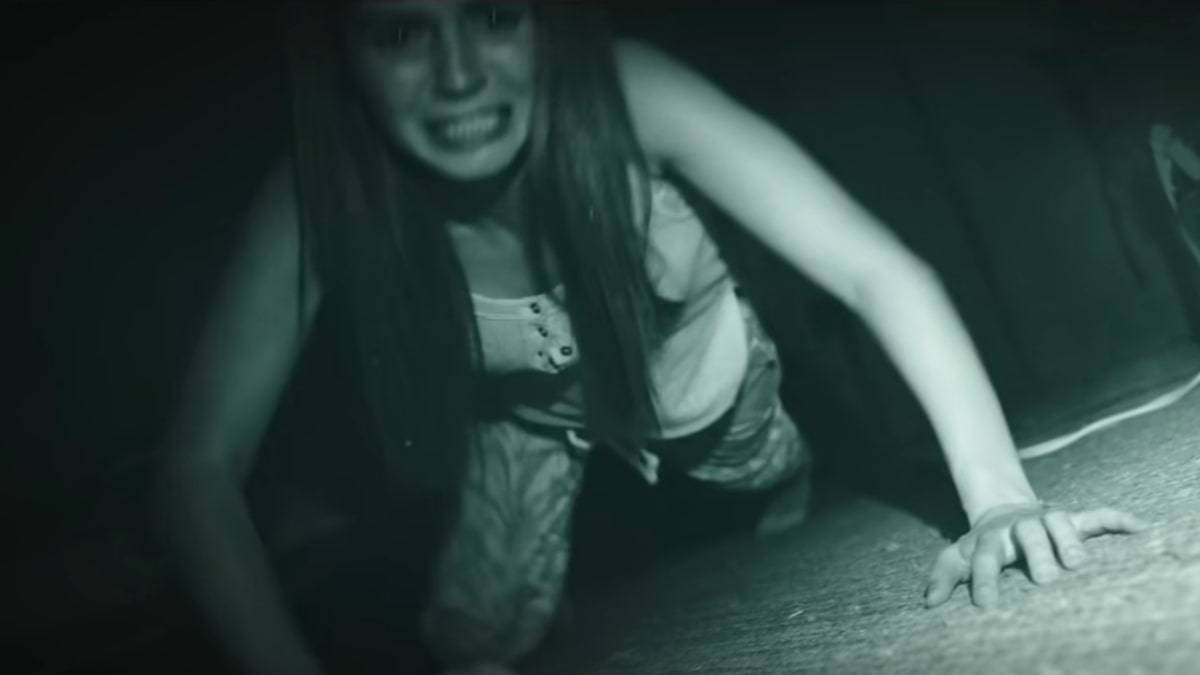Editorials
Alchemy and Hermeticism in ‘As Above So Below’
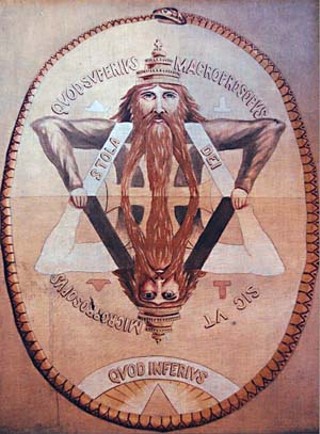
First and foremost, this is not a realistic film in any sense of the word; the audience needs to heavily suspend disbelief for the entirety of the 93-minute movie–it’s very much a haunted house attraction that doesn’t let up until the credits roll.
The film follows Scarlet, an archaeologist who is searching for the fabled Philosopher’s Stone and Nicolas Flamel’s tomb, which she believes to be in a hidden chamber in the Catacombs of Paris. Accompanying Scarlet is Benji, an American documentarian who is making a feature about the woman; George, an old friend/love interest and fellow student of theological and mythological folklore and history, as well as a talented linguist; and three urban explorers who act as the interim tour guides for our three characters–leader Papillion, climber Zed, and token goth chick, Souxie.
One of the heavy positives of ‘As Above So Below’ is the fact that after setting up the extremely clear plot of the film, they get down into the catacombs and into the action within the first 15 minutes.
SPOILERS FOLLOW:
A BRIEF HISTORY OF ALCHEMY
Harry Potter fans will be familiar with this story: Nicolas Flamel was a scrivener and manuscript seller in 14th century France, and died in 1418. It’s fabled that he was also an alchemist and succeeded in creating the Magnum Opus: the Philosopher’s Stone. The Philosopher’s Stone is a legendary substance that is said to be able to turn any base metal into gold, as well as provide everlasting life, everlasting youth, and rejuvenative qualities. Also Flamel designed and made his own tombstone, which many believe hold a guide within the arcane symbols and language to finding the Philosopher’s Stone (including our protagonist, Scarlet).
One of the most interesting and obviously important aspects of the film is alchemy. The entire plot of the film insists on it. The title is the shortened mantra of alchemy and Hermeticism: “That which is Below corresponds to that which is Above, and that which is Above corresponds to that which is Below, to accomplish the miracle of the One Thing. “In simpler words: As it is above, so it is below, as it is within, so it is without. The mantra is clearly illustrated in the painting below:
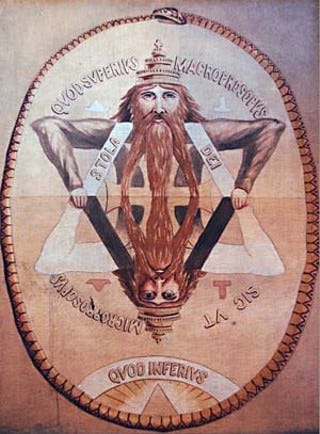
As you can see from the image, everything in the lower half is the exact same as the upper half, only opposite. Sound familiar? As Scarlet & Co. venture deeper and pass through the “gate to hell,” the entire catacomb layout flips and the group essentially goes through the exact same rooms and motions they had just gone through, however all of the details are the exact opposite. The only thing that remains constant is the fact that they keep going down. A phrase that seems wildly familiar when you think back to Dante’s Inferno, a text that this film borrows heavily from.
“WE HAVE TO KEEP GOING.”
The phrase heard more often throughout the film than anything else, and for good reason. When Dante and Virgil begin to enter into Hell (Canto III), the inscription above the entrance is “Abandon all hope, ye who enter here.” Similarly, it is the same phrase written in what is presumably Aramaic (because Scarlet can’t read it, but George can) over the tunnel in the film that leads to the “below” portion of the catacombs, which also happens to be Hell.
Now to backtrack a bit in the film: When the group first enters the catacombs, there’s a blocked off route that leads directly to where Scarlet believes the hidden chamber to be, however Papillion informs them that according to urban legend, anyone who goes through that tunnel does not come out. In fact, Papillion even had a friend, La Taupe (English: The Mole), that was an urban explorer obsessed with knowing every corridor, tunnel, and room in the catacombs, but refused to enter in this specific route. After curiosity got the better of him, he went through the route and was never seen again.
It’s only after their primary route collapses that they go through the blocked off route. After entering into the blocked off area (and what plays out hauntingly like Dante’s Purgatory), they run into their lost friend La Taupe, who Papillion says has changed, and is not the same. La Taupe bears a blatant similarity to the souls wandering in Purgatory, as well as the souls trapped in the first circle of Hell in the Inferno: Limbo.
Furthermore, through Dante’s descent into Hell, the circles get smaller and smaller, as well as contain pouches for specific subsets of sins, as illustrated in Botticelli’s painting of Dante’s hell.

If this painting isn’t ringing any bells, call to the mantra of the film “We have to keep going,” along with what Dante and Virgil discover through their journey through Hell: The only way out is down (a line that La Taupe borrows word for word when promising to show the group the exit). In Dante’s Inferno, the only way to exit Hell is to travel all the way through it, and by going through the final circle Dante and Virgil find that gravity flips, and they exit out near where they entered in. This EXACT circumstance is what plays out in the final minutes of the film–jumping down the well, the manhole’s odd gravitational pull, and then the group exiting by “jumping up” out of a sewer.
“V.I.T.R.I.O.L.”
Vitriol the archaic term used for sulfuric acid. As you learned in the film, it’s also the acronym motto of alchemy: VISITA INTERIORA TERRAE RECTIFICANDO INVENFIES OCCULTUM LAPIDEM which roughly translates in English to “Visit the earth’s interior parts; by rectification you shall find the hidden stone.” Yes, that is the plot of the entire movie. Yes the most important word in that sentence is “rectification” or “to make right; correct.” Yes the purpose of Dante’s Hell is to punish sinners for their wrongdoings on earth by rectifying them in a perverted way. Yes vitriol literally eats away at things, revealing that which lies underneath. The metaphors and references of this phrase contained within ‘As Above’ are pretty extensive. It’s all making sense now.
THE CHARACTERS, OR: WHY THEY MUST ALL RECTIFY
Scarlet: The film begins with Scarlet searching for the fabled Rose Key in Iran, which of course she finds. The Rose Key is a giant statue that contains Aramaic instructions to understanding arcane symbols, which Scarlet believes will lead to Flamel’s tomb. Cool, all good so far. Except after she finds the Rose Key–which is in a cave that the Iranian government is blowing up for unknown reasons–and is getting ready to exit, she sees a hanging body in the corridor, which we only see for about 1 second before the system begins to explode and Scarlet barely escapes with her life. Was the body really there or just a hallucination? Well, we learn in the next scene that her father killed himself and can easily deduce that the body was a hallucination of her hanging father (if you didn’t easily deduce this, it’s explained in the films final act). In the final act we learn that Scarlet blames herself for father’s suicide because he called her the night he hanged himself, but she never picked up the phone. She does pick up the phone in the purgatory section of the film, as well as “rectify” her guilt by stating it.
George: We learn very early on that George has a grudge against Scarlet, along with some horribly blatant sexual tension (which thankfully doesn’t drag the film down as they quickly resolve it and don’t ever reference it again until halfway through the final act, in which case they settle it once in for all in a two line exchange of dialog), as well as a very passionate and clear hatred of caves, catacombs, sewers, and basically any underground system. In typical horror fashion, George does not want to go on the expedition, but winds up in the catacombs with the group through a very brief series of unfortunate events, which then expounds into 80 minutes of unfortunate events. The reason for George’s disdain of underground systems: his brother drowned in a cave when they were children. In the final act, George states that he told his brother he was going to get help, got lost, and his brother drowned waiting to be saved. By stating this aloud and “rectifying” it, as well as being the most obviously innocent character in the film, George is also allowed to leave through the well.
Benji: Benji shows patterns of lust throughout the film, which also happens to be the second circle in Dante’s Inferno. From commenting on the attractiveness of the museum curator to curiously following the ‘creepy young woman in white’ with his camera throughout the club sequence, Benji’s lust is only present at the beginning of the film, and once they enter the catacombs, it’s never brought up again. Benji doesn’t have much time to rectify before he’s killed by the ‘creepy young woman in white’ or a vision of her in the tombs. When Benji sees the woman, you have to almost watch it frame-by-frame, or at least know exactly what you’re looking for to notice that she is carrying an infant with her. Could this be a child he fathered through an act of lust? I have no idea, and I doubt the writer knows.
Benji’s and Souxie’s deaths were only necessary in order to have a higher kill count in the film, which isn’t even a staple of the found-footage genre. It’s extremely irritating that in such a well executed film, the screenwriter didn’t deal with the theme of rectification with all characters across the board. This leads to little to no character development with Benji and Souxie, which is unfortunate as they could have both lent more to the entire “personal sins” aspect of the film.
Papillion: When we are first introduced to his character, we see a burn scar on his hand. Throughout the film, we are shown various burns on that arm, but only if you are paying very close attention. Other than Benji’s question to Zed about Pap’s burn, and Zed immediately shooting down the question with a response of “We don’t talk about that,” Pap’s burn is never discussed again until the burning car scene, which lasts all of 45 seconds and ends abruptly.
This would not bother me at all if we were given even just a few more lines of dialog about his character. I mean, I understand keeping things vague, but we are introduced to the burning boy in the car which sucks Papillion in as he repeats “It wasn’t my fault,” and results in the car imploding, leaving Papillion buried in the sand with only his legs from the knee-down sticking up out of the sand. While it’s upsetting the writer decided not to delve deeper into certain characters, this image is really all you need to know about Papillion.
In Dante’s Inferno, this is the image that Dante and Virgil are subjected to when visiting those guilty of Simony, or the buying and selling of ecclesiastical privileges (Eighth Circle, Canto XIX). In old Christian mythos, it was believed that by paying a member of the church a specific amount, one could gain privileges with God without having to show penance. Papillion is only interested in one thing from the expedition: material wealth. He is also exceedingly arrogant. Moreover, it is his greed in the tomb to possess the riches that lead the group to their descent into hell. Instead of admitting his wrongdoings and rectifying his past guilt, Pap instead is dragged to his grave screaming “It wasn’t my fault.” Sidenote: The screenwriter refusing to give Benji and Souxie equally satisfying deaths that pay off in the form of refusing to rectify is one of the biggest faults with the film.
Souxie: Token goth chick that gets her head smashed in by the “below” version of La Taupe. Absolutely no character development. Basically Papillion but female and on a much smaller scale. Completely unnecessary character other than to have a higher kill count.
Zed: For the first two acts of the film, Zed’s character is auxiliary at best, until the group is diminished to the final three, in which case he acts as the new documentarian. It’s in this final act that Zed’s character becomes rapidly developed, and extremely sympathetic–George and Scarlet know exactly what is going on, they are learned and have studied these subjects extensively, while Zed is understandably horrified and relying completely on the information and direction of two people he’s known for all of half a day. In the rectification sequence, Zed admits that he has fathered a child that he knows to be his, but actively denies, and shows genuine guilt and sorrow in this fact. He is rectified and allowed to leave through the well.
THE FINAL FLOOR, THE WELL AND PURGATORY
While the group of three are frantically running through the final floor of the catacombs, they come across a hooded, masked figure who wanders around to supply a few scare sequences before it’s penultimate scene sitting the the chair and rising to face the group. While it’s chair is a seemingly ordinary, wooden chair, it’s clear that this figure is meant to–at least in this specific scene and room–symbolize Satan and his throne. As Dante and Virgil must pass Satan to exit Hell, so must our explorers pass the hooded figure to exit the catacombs.
In the hooded figure’s final appearance, we see what looks like multiple figures walking alongside. This could be interpreted many different ways, though nothing that correlates with Dante’s Inferno, and as I saw it they are just the “bottom” version of the cult dressed in white that the group encounters at the very beginning of their journey. I would have commented on this group sooner, except they serve no purpose other than atmosphere and a reason for the earlier mentioned ‘creepy young woman in white’ to be present in the catacombs to offer a jump-scare and kill Benji–useless. Also in this section of the film, we are introduced to the stone monsters which play out more like a lesser version of the weeping angels from Doctor Who. To my knowledge there are no stone creatures in Dante’s Inferno, other than those who are turned to stone by staring at the Furies, which these stone figures could represent. Remember, many have entered the forsaken route but no one has ever come out before. These stone monsters (which also crumble surprisingly easily) could represent those who have journeyed into the abyss and never rectified their sins.
In keeping with Dante’s mythos, the well at the end of the film that leads Scarlet, George, and Zed back to the surface symbolizes not only the rectification of past sins, but also purgatory itself. In Dante’s Purgatorio, Purgatory is a giant allegory for internal introspection, admittance of one’s own faults, and only by climbing through the first seven terraces, which all represent the seven deadly sins, will one reach the earthly paradise. By admitting and rectifying their sins, the three are purged and cleansed, and allowed to exit the “below” section of the catacombs.
ENDING THOUGHTS
The film was not without its faults, some of which I have already discussed. Because it is shot in a mockumentary/found-footage style, the shaky-cam and shaky-lighting staple of the genre is obviously employed, and becomes annoyingly infuriating during 3 sequences I can think of, one of which is in the first 4 minutes of the film. If you’re able to get around these sequences, all of which add up to only about 2 minutes of the film when combined, then you’ll be good. The rest of the cinematography is gorgeous and frightening and feels very much like a blend of [rec] and The Descent. Likewise, the atmosphere of the film borrows heavily from the claustrophobic aspects of The Descent while also calling to mind an extremely well executed haunted house attraction, complete with creepy, ringing telephones, pianos, dead bodies, and other frightening or unsettling images.
This is the best film I’ve seen set in the Catacombs of Paris because they let the catacombs be creepy for themselves. The characters in the film offer a brief history of the catacombs, which adds to the terror, but other than that, the walls lined with skulls, dripping ceilings, bones scattered throughout, and harrowing darkness are a perfect ambiance and atmosphere to compliment the expedition story.
The acting was also particularly good by the entire cast, and while some characters were not utilized to their full potential, the four characters who were explored were done so in a way that left the audience satisfied while still keeping with the vagueness implied with found-footage horror.

